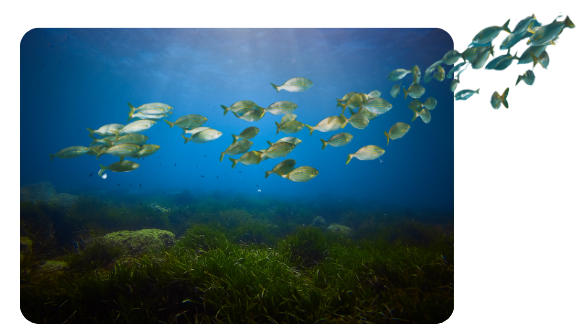Story
Knot your average vessel... Plymouth Quest gets upgraded for a new era of marine science
09 May 2025
Our beloved research vessel, the Plymouth Quest, has been in Penzance for the last few months undergoing some impressive upgrades to help us continue to deliver science for ocean action, and to uphold the longest marine dataset in the world – the Western Channel Observatory.
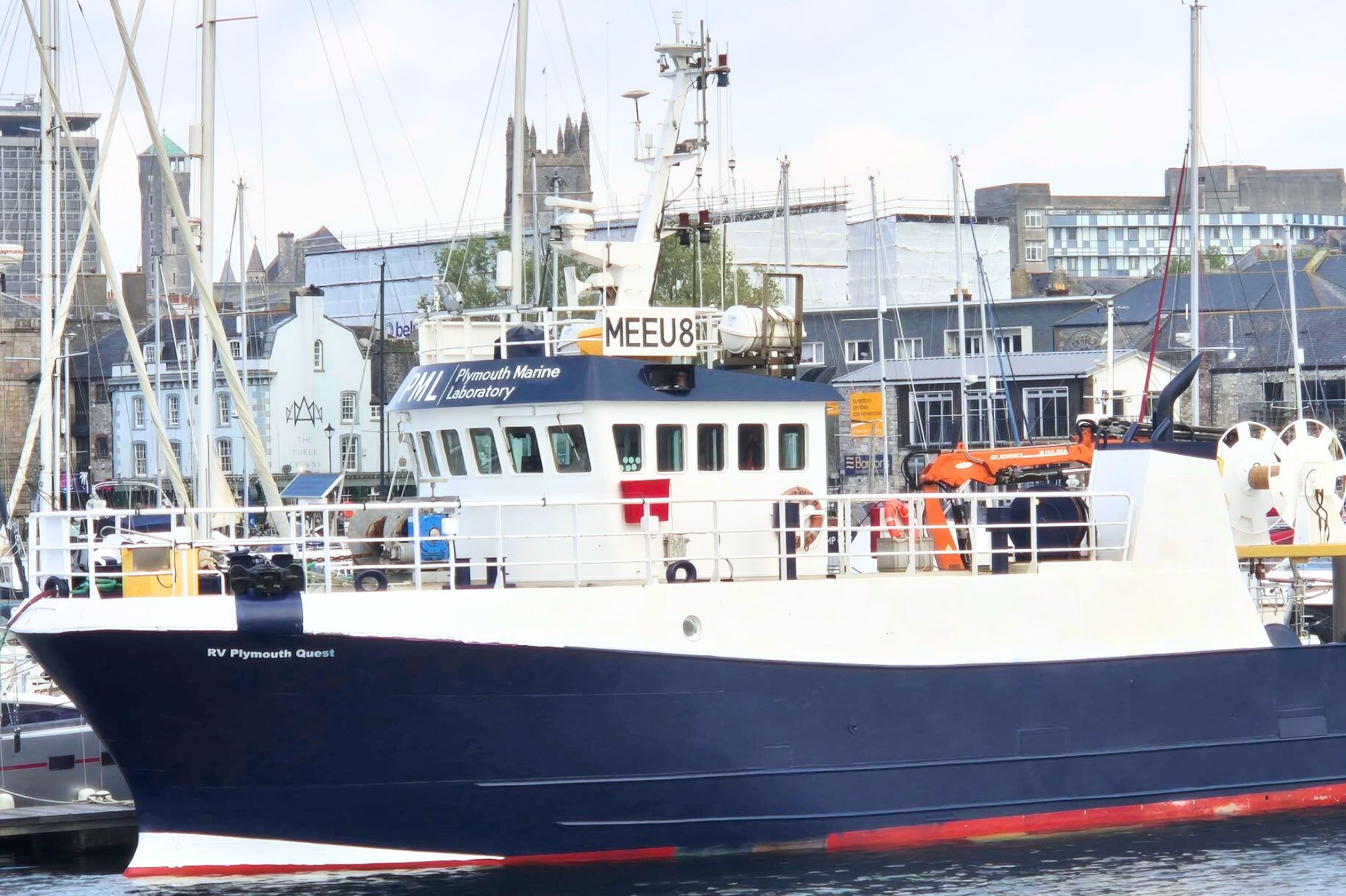
The RV Plymouth Quest is now almost 25 years old. She was built in Dalian, China in 2001 as a wet fish trawler, and was named originally named Sigurbjorg, and operated out of Iceland.
Sigurbjorg is a Nordic name, specifically a female form, with roots in the Old Norse language. The name combines “sigur” (victory) and “bjorg” (bear).
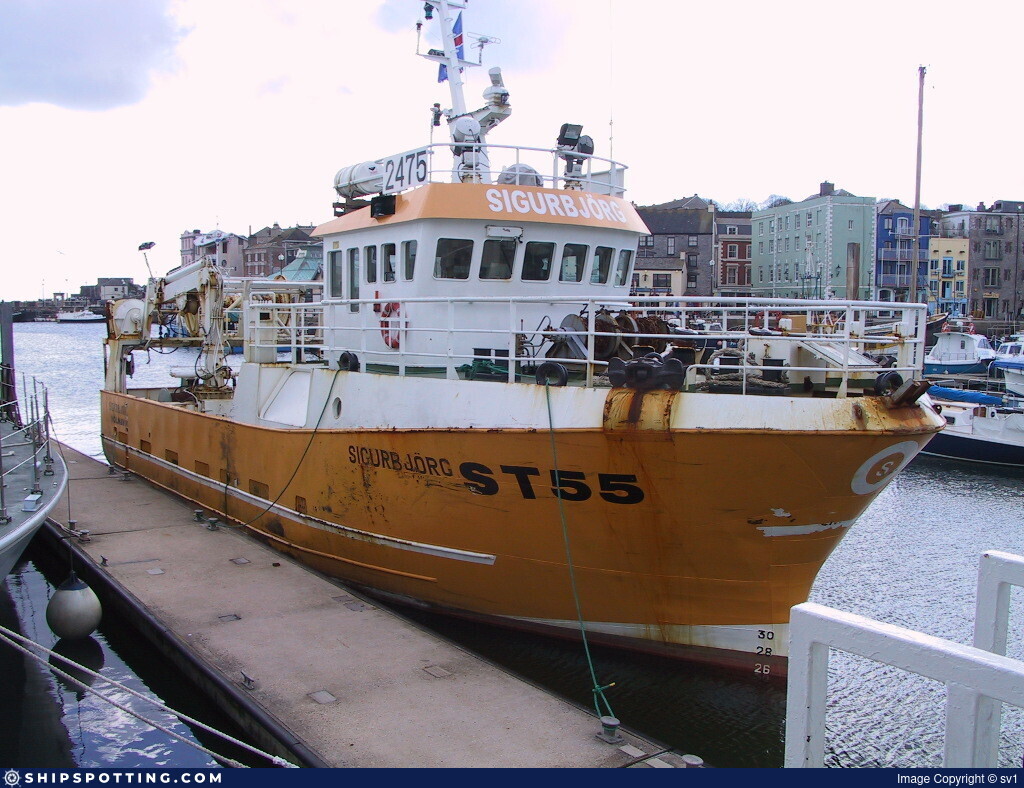
Above: Sigurbjorg arriving in Sutton Harbour, Plymouth, before she was renamed the RV Plymouth Quest and her new journey enabling marine science began.
Plymouth Marine Laboratory acquired the vessel from the Icelandic owner in 2004, and she was renamed the Plymouth Quest during a naming ceremony in July of that year. Quest has since been used to conduct vital marine research including long-term monitoring as part of the Western Channel Observatory – an oceanographic time-series and marine biodiversity reference site in the Western English Channel. Marine data collection in this area dates back to 1903, and it is the longest running, near-continuous marine dataset in the world.
Quest operates in coastal and offshore regions and is able to spend up to 5 days at sea. Over the years it has been equipped with facilities for manually collecting a wide range of biological, chemical and physical measurements, and it also boasts a suite of underway sensors for autonomous measurements.
However, after almost twenty years of steadfast service, Quest needed a little more than the typical maintenance and servicing, for both safety and science.
Our Skipper, Andrew (Andy) Perkin, who has been working at PML for almost twenty years, took us on a tour to show us the new features and tell us about the work behind the scenes.
We met him at Sutton Harbour, the morning after Quest returned from Penzance.
“It’s been a lot of work, and I am beyond proud of the crew for the hours and energy they’ve put in. They’ve been travelling down to Penzance every day on the train to the workshop to get stuck in with the refit. They’ve been long days.”

Image caption: We met Andy and the crew at Sutton Harbour, the morning after RV Plymouth Quest returned from Penzance.
“We’re really chuffed with the new features and functionality. One of the biggest upgrades we’ve had fitted is a bow thruster – this significantly improves the maneuverability for research vessels during sampling at sea. It means we can make precise lateral movements – important for station-keeping in confined or challenging environments such as near coastal areas or during sensitive sampling procedures.”
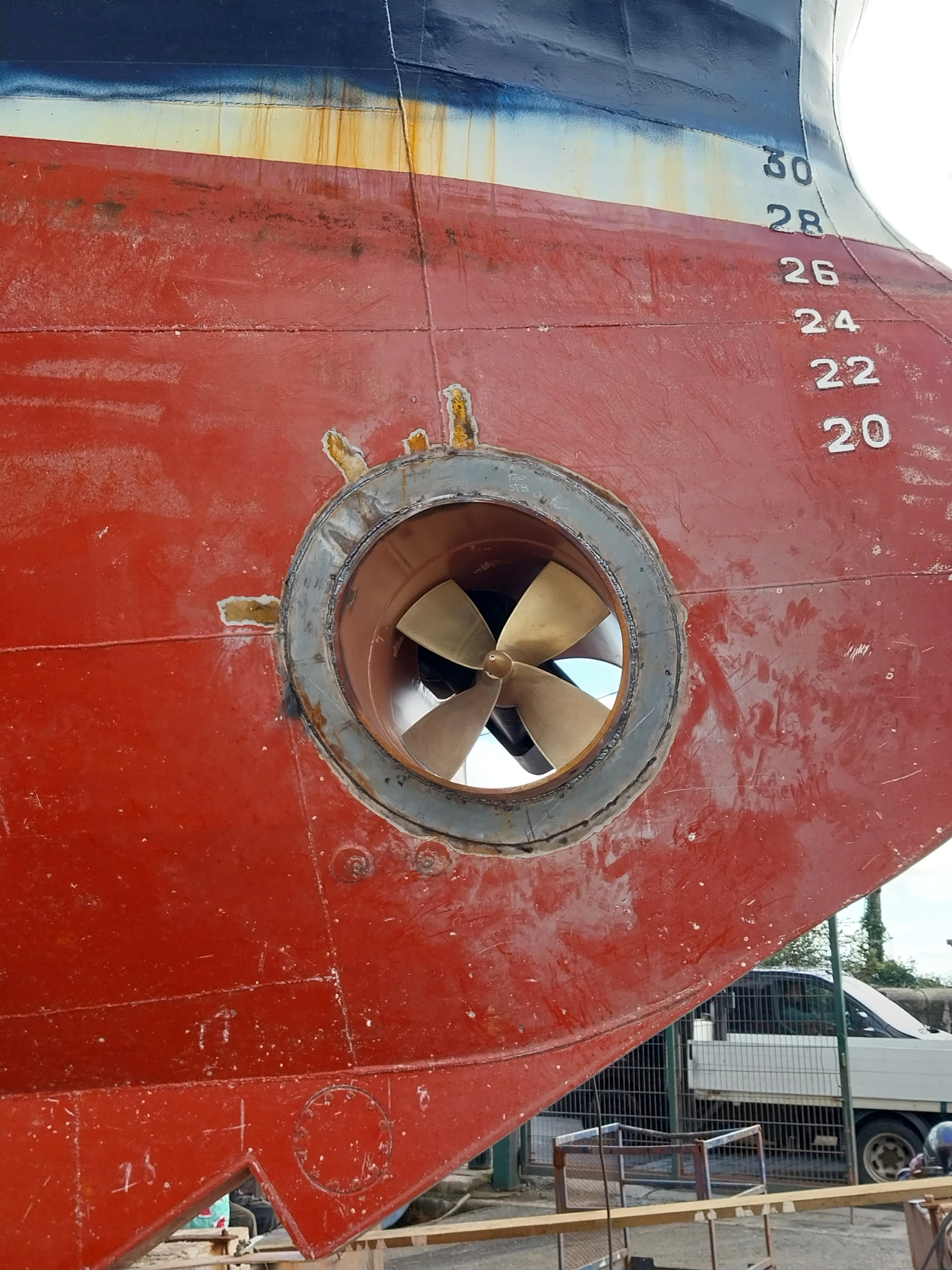
Image caption: The new bow thruster sits at the hull of Quest, and this will now allow the crew to make precise lateral movements.
Seeing it in action, Andy uses the bow thruster to carefully inch the Quest sideways closer to the dock, as Gary Stevens, Deputy Skipper, kindly lends a hand to get me safely onboard.
Andy continues:
“As you can see, this bow thruster helps in positioning the vessel accurately. It can do this even in adverse conditions, like strong currents or wind.”
“This will make sampling trips safer for crew and scientists on board, by enabling quick adjustments, and minimising drift during sampling. It also reduces the need for continuous main engine adjustments, so this helps save fuel and minimise environmental disturbances – which is crucial, as we aim to interfere with marine life as little as possible.”
On the topic of the environmental impact of the vessel, Andy explains that Quest runs on clean fuel, using recycled vegetable oil; Hydrotreated Vegetable Oil (HVO) diesel. He says, “It’s better for the environment,” and adds, “it smells a lot better, too.”
The new bow thruster was welded in with thanks to local businesses including Mike and Andy from APR Marine Fabrications, alongside Russell of Penwith Marine Services. Andy says, “This was a huge job, and Mike, Andy and Russell have been fantastic. We couldn’t have done it without them.”
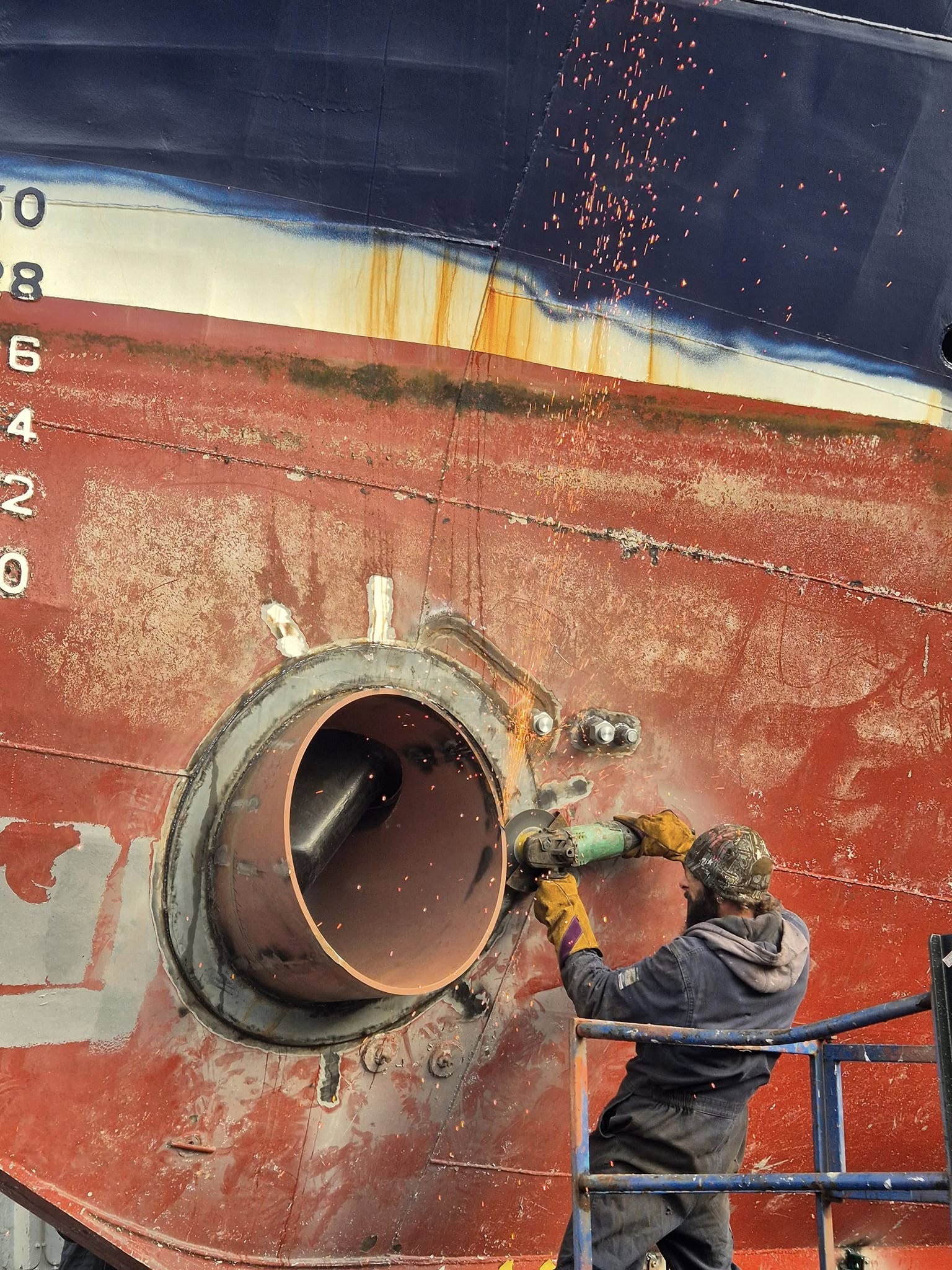
Image caption: “We couldn’t have done it without them.” Mike of APR Marine Fabrications welding the bow thruster to Quest during her refit.
Andy walks us through the top deck and control room. He has a seat in the corner, located by the main controls, which now includes an additional group of controls for the new bow thruster.
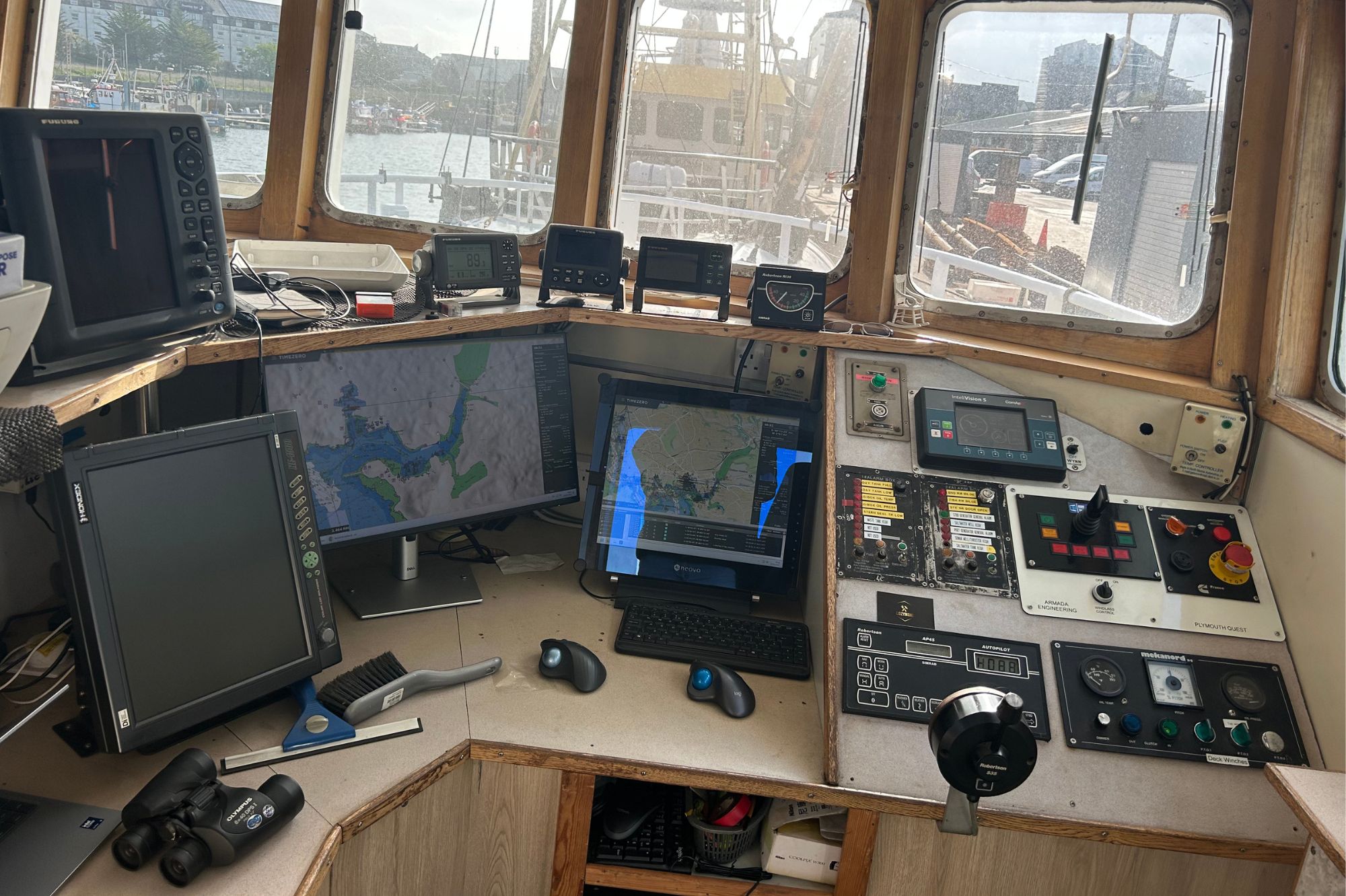
Image caption: on the far right, you might see a black control stick surrounded by red, yellow and green square buttons – there sits the bow thruster controls.
“We’ve also had brand new hydraulics fitted, these power critical equipment on board, like the winches, thrusters and all mechanical items – basically, all of the machinery that helps us collect all of the different kinds of marine samples needed to deliver the science.”
“Modern hydraulic systems are essential for meeting the latest marine regulations. Quest ticks all of the right regulatory boxes – upgraded so that it’s safer, more reliable, and fully legal – and just as importantly, it makes sure we stay operational, compliant, and ready for whatever the next voyage throws at us. Again, all of this work has been completed thanks to APR Fabrications and Penwith Marine Services.”
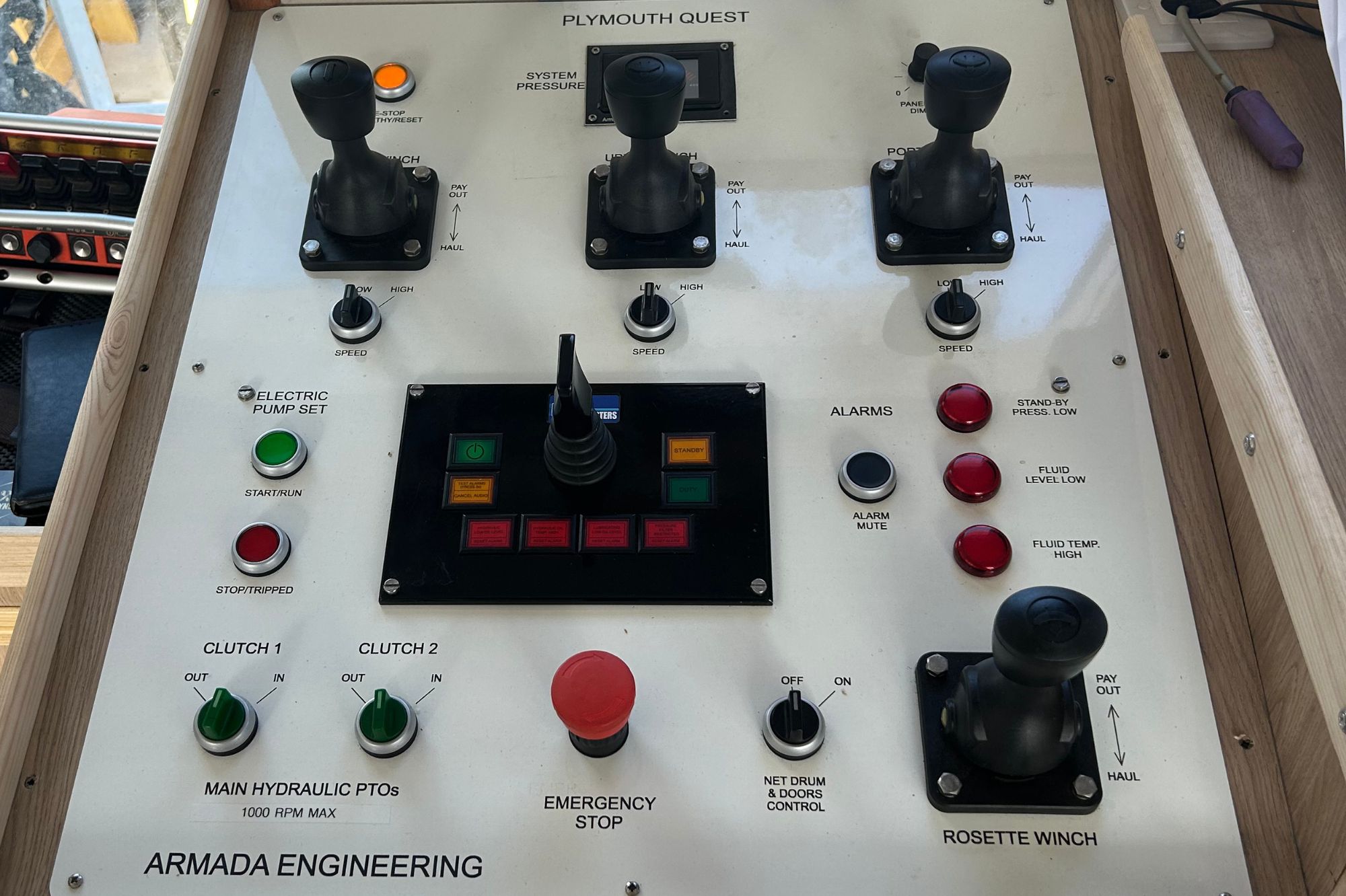
Image caption: Another control board, this one manages the hydraulics on board. Hydraulic systems can be complex and require specialised knowledge for installation and maintenance.
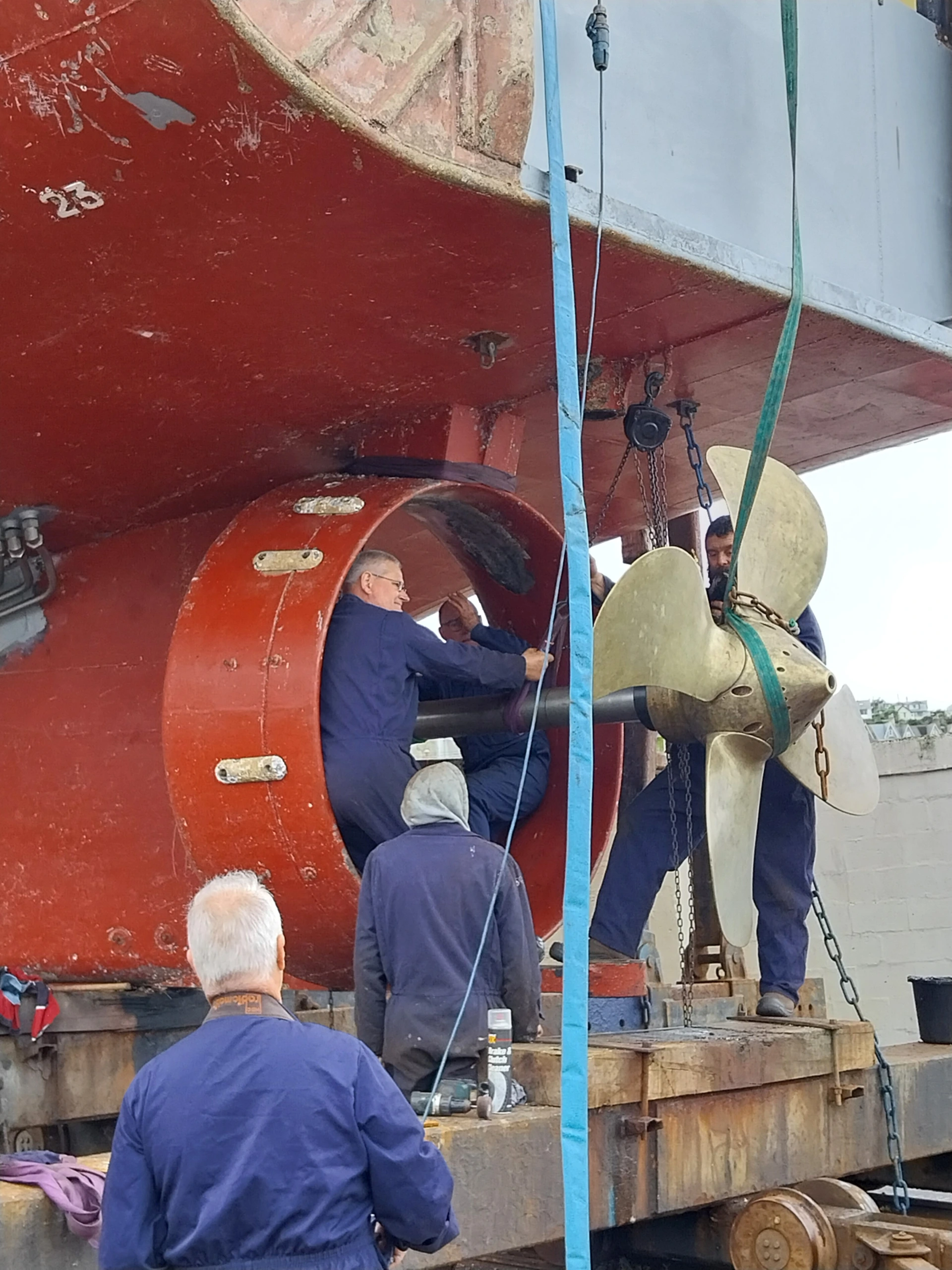
Image caption: Teamwork between APR Marine Fabrications and Penwith Marine Services, fitting the propellor.
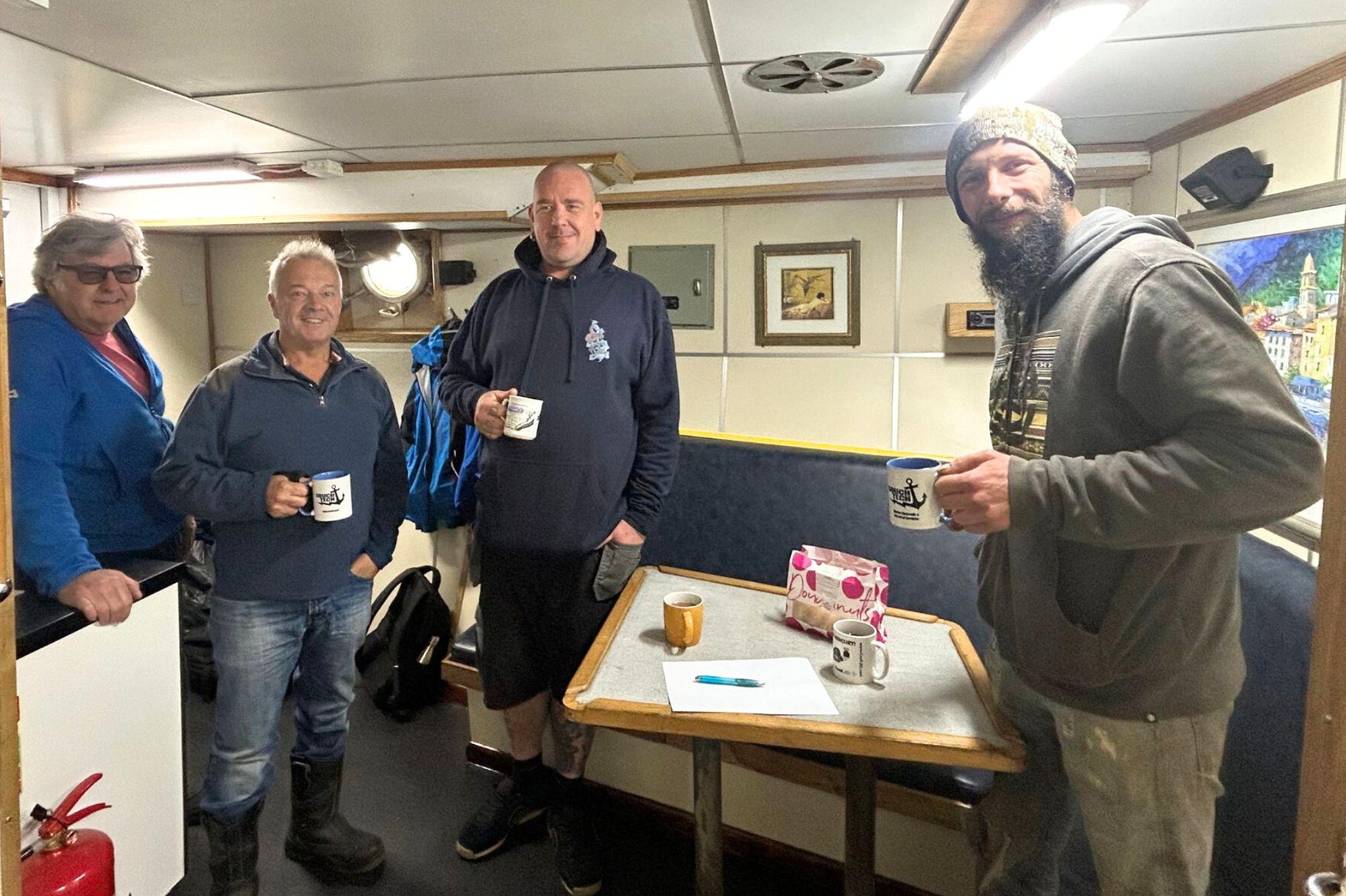
Image caption: (from left to right) Andy, Gary, and Andy and Mike of APR Fabrications, enjoying a well-earned cup of tea.
After a tour of the top deck, Andy takes us downstairs to show some improvements made to the living area for crewmates. The previous toilet and shower room has been refitted as a small office working space for the crew, and some new kitchen units have been added to update the decades-old galley. “It’s a much better space for the crew.” Andy says.
In addition to Andy and Gary, the crew – also known as the Marine Services team – also includes Georgina Ramm, Ships Science Officer, Tristan Jaycock, Marine Engineer, and Andrew Pawley, Engineer. The crew can spend entire days onboard Quest, so it is important that it is fitted correctly to ensure the team can operate effectively and safely.
One of the biggest visual changes during the refit is the renovation of the old ‘fish room’ – a dark and cavernous space beneath the main deck which had been previously been used to store fish by Quest’s previous owners.
“Until now, the fish room had only been accessible down a a ladder through a hatch on the deck,” Andy explains, “This could be dangerous for crew to get down, especially during choppy waters.”
Now, there is a staircase leading down to the room, which is well-lit with overhead lighting. Supporting with this part of the renovation was Lozynski Carpentry and Marine Services.
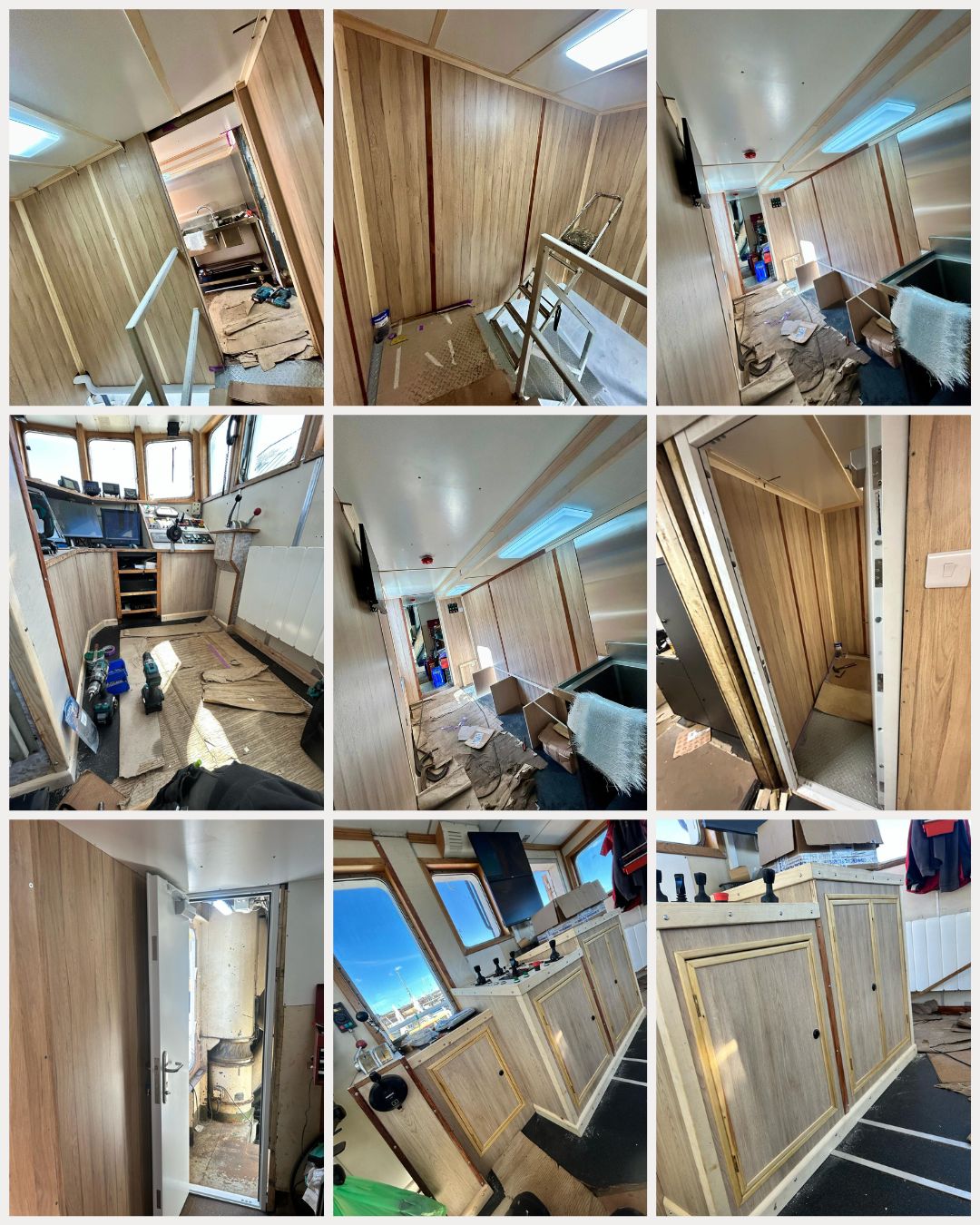
Image caption: A gallery of images showing the work in progress by Lozynski Carpentry and Marine Services, who supported with much of the internal renovations.
The stairs lead down into the ‘fish’ room, which now hosts a suite of the latest scientific instruments, in addition to new water tanks, the underway system, and the new shower and toilet room.
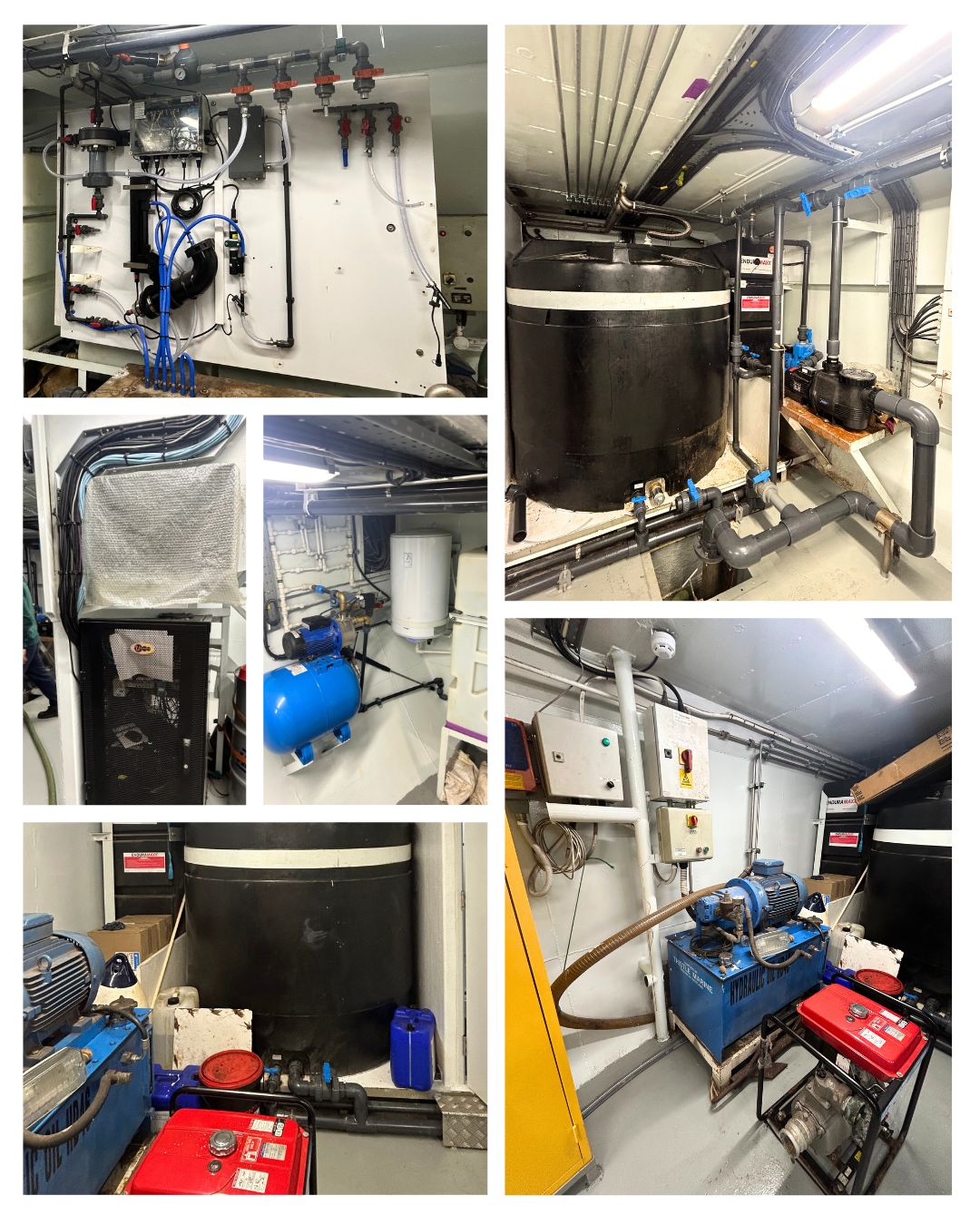
Image caption: Some of the technology now hosted in the ‘fish room’
Professor James Fishwick, Head of the Marine Technology and Autonomy group at PML, has been leading the refit of the latest autonomous technology installed on the vessel. He commented on the work involved:
“Over the past 20 years, PML has continuously developed and enhanced the scientific systems aboard the Plymouth Quest. The recent refit provided a unique opportunity to modernise and future-proof these systems to meet the evolving demands of marine research.”
With bulkheads removed during the refit, the Marine Technology and Autonomy team—Ross Sanders, Kieran Pechelski, and James Fishwick—had unrestricted access to install infrastructure throughout the vessel. This allowed them to deploy a state-of-the-art computer network interconnecting all operational areas. Alongside this, they established a dedicated power supply for scientific instrumentation, supporting both 24V and 12V systems.
Professor Fishwick continues:
“Drawing on over 25 years of operational experience, we have implemented access and control boxes at strategic locations, including the main deck, mast, and bow. These boxes provide versatile access points for both power and data connectivity, enabling seamless integration of scientific equipment. All data and control lines now converge at a central system control unit located in the former fish room. From this hub, data from onboard sensors can be routed to newly installed displays across the vessel.”
“Furthermore, key scientific sensors have been fully integrated into the network, making GPS, meteorological data, and information from the underway sensor suite accessible throughout the ship—eliminating the need for additional cabling. The vessel is now capable of collecting high-resolution scientific data via both its autonomous underway sampling systems and the advanced water column profiling rosette.”
“To support real-time data transmission to Plymouth Marine Laboratory (PML), the team have integrated the onboard systems into the advanced mesh network that underpins the Western Channel Observatory. This enables seamless transmission of data while at sea, with automated processing and online availability through established PML data pipelines.”
“These comprehensive upgrades significantly enhance the operational capabilities of the Plymouth Quest, positioning her as a versatile platform for modern oceanographic research. She is now equipped to support and coordinate with autonomous surface and subsurface vehicles, reinforcing PML’s leadership in marine science and supporting key initiatives such as the Western Channel Observatory, the National Centre for Coastal Autonomy, and Smart Sound Plymouth.”
PML’s Chief Executive Professor Icarus Allen and Director of Science Professor Steve Widdicombe went out to visit Quest, halfway through her refit, during the Winter months.
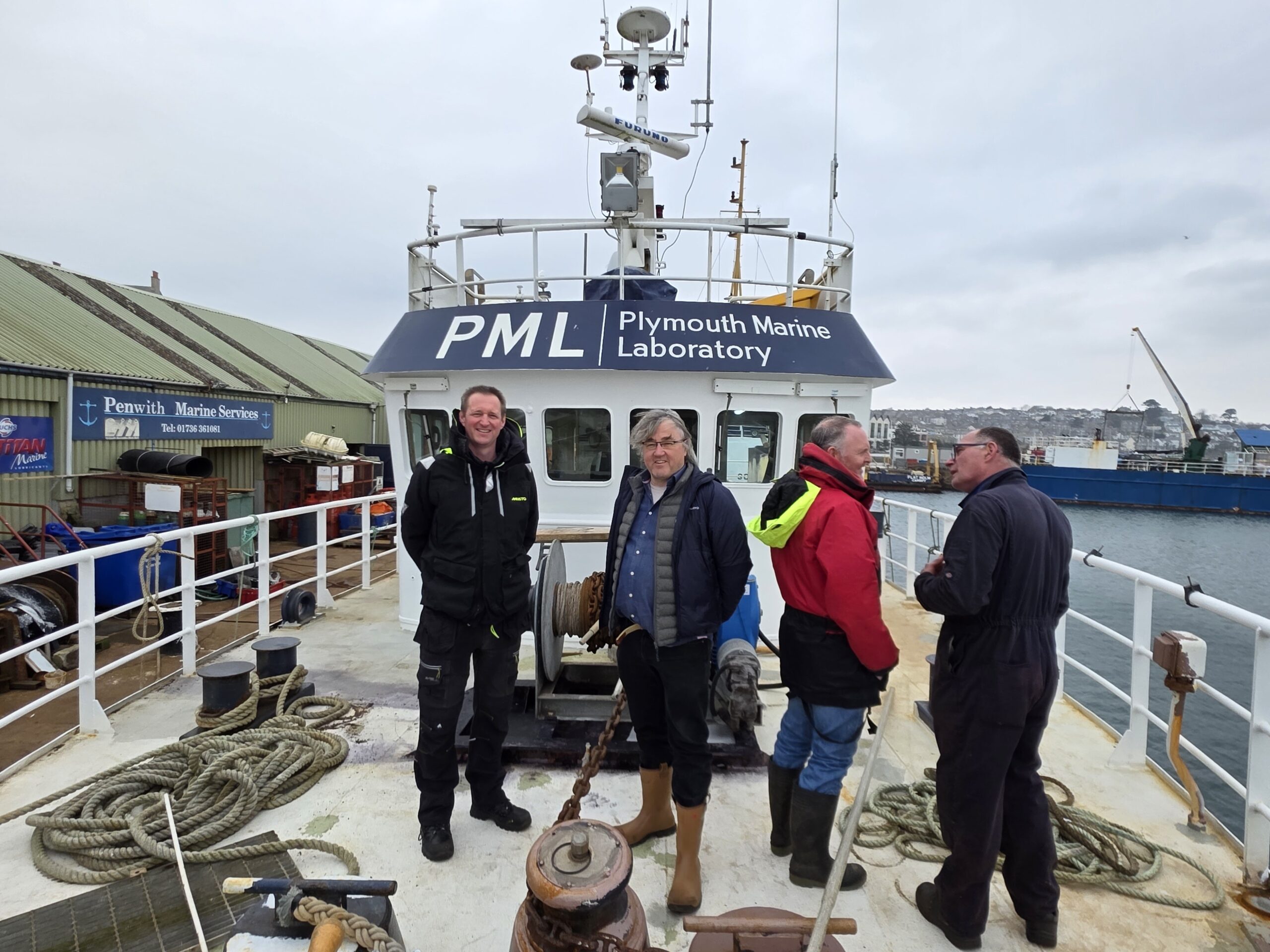
Image caption: (from left to right) Professor James Fishwick, Professor Icarus Allen, Professor Steve Widdicombe and Andrew Pawley, visiting Quest halfway through the refit.
Professor Allen reflected on the significance of the refit:
“The Plymouth Quest is more than just a vessel – it’s a cornerstone of our ability to deliver world-class marine science. This refit represents a significant investment in the future of ocean observation and demonstrates our commitment to climate and biodiversity research. As we face mounting environmental challenges, having reliable, modern infrastructure to support long-term datasets like the Western Channel Observatory is absolutely essential. The Quest may be 25 years old, but she’s now equipped for the next generation of science.”
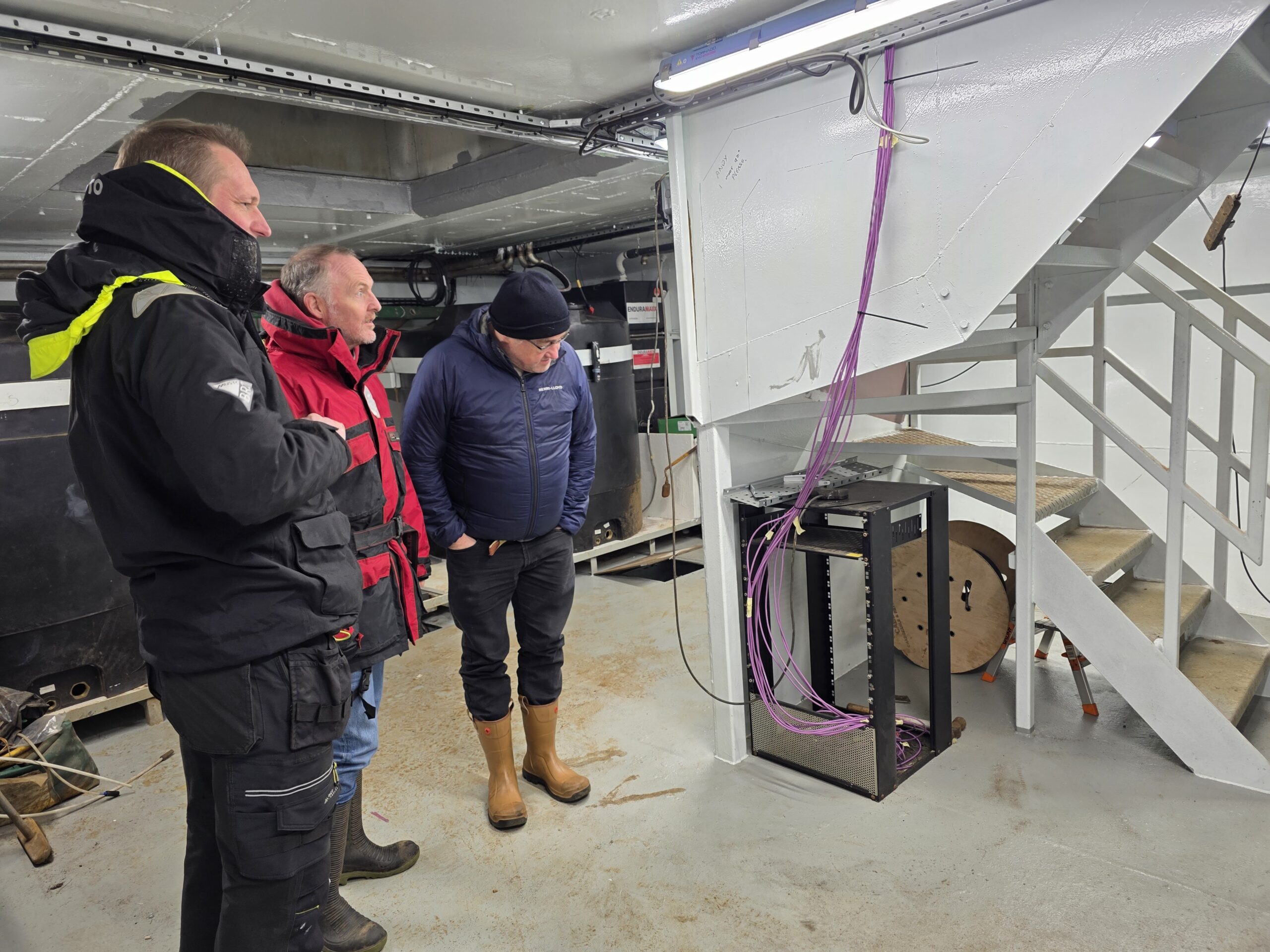
Image caption: (from left to right) Professor James Fishwick, Professor Steve Widdicombe and Professor Icarus Allen, visiting Quest halfway through the refit.
Professor Widdicombe commented on the science made possible with Quest:
“The Western Channel Observatory is one of the most important collections of marine timeseries in the world, and the Plymouth Quest plays a crucial role in maintaining it. These upgrades to the vessel not only improve its safety and efficiency for the crew and scientists, but also enhance our ability to collect high-quality, long-term data – the kind that helps inform real action for ocean health. It’s exciting to see her back on the water, fully equipped to tackle the scientific questions of today and tomorrow.”
John ‘Mac’ McDonald, Head of Marine Operations, has ensured the science continues whilst Quest has been undergoing the refit. He said:
“Whilst Quest has been out of action, we’ve organised the use of other vessels to maintain regular sampling. We would like to thank the Marine Biological Association for their support during this period, allowing us to make use of their vessel the RV MBA Sepia to continue the science.”
Commenting on the refit and work involved, he adds:
“It’s been a massive effort behind the scenes – huge credit to the crew and everyone involved in getting her shipshape again. She’s got a few days of shakedown sampling ahead, then we’re back to doing what we love: working at sea and delivering top-notch science.”
The local businesses involved spoke about their work bringing the refit to fruition.
Andy of APR Marine Fabrications said:
“We were delighted to be asked to assist in this project. The upgrades made to the vessel mark a significant step in extending the vessel’s operational life and enhancing its capability to support the most cutting-edge marine research. The refit along with the structural modifications ensure the vessel remains a reliable platform for scientists to do science stuff.”
Lozynski Carpentry & Marine Services said:
“It was an absolute honor to contribute my skills, fitting trims and skirtings, to the remarkable refit of the Plymouth Quest Marine Laboratory vessel—a privilege to be part of such an extraordinary project!”
To finish our chat with Andy, we asked him whether, after all these years, he has gotten attached to Quest, like you might an old reliable car.
“Yes, you definitely get attached. We’ve had some great memories here, with great people. It [the crew] feels like family – me, Gary and Andrew have worked together for years. And it’s been such a welcome to have Georgie and TJ on board – new energy, and the next generation.”
“And I have fond memories not just with the boat crew, but with scientists from the laboratory like Amanda Beesley, Louise McNeill, Jo Nunes, James Fishwick – great friendships have been made over the years working together, collecting the science.”
